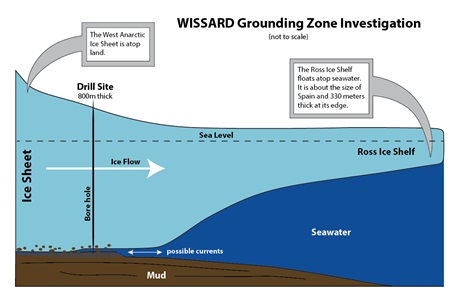Outside my window, New York City is experiencing a blizzard. The city is on high alert: the mayor is issuing all sorts of proclamations while, at the grocery store, a horde was stripping the shelves bare. Meteorologists and weather scryers warn that the city could be in for up to 36 inches of snow!
Being forced to live under 3 feet of snow is an alarming prospect to me, but it is nothing for the life forms which were just discovered by a team of scientists exploring the extreme ecosystems of Antarctica. The Whillans Ice Stream Subglacial Access Research Drilling (WISSARD) project has just drilled through the Ross Ice Shelf—a gigantic sheet of ancient ice which covers an area approximately the size of France. The amazing (albeit stupidly named) WISSARD team drilled through 740 meters (2,430 feet) of shelf ice by means of a specialized hot water drill in order to lower a cylindrical robot submarine into this hidden sea. The insertion point for the probe was near where the ice sheet, the ocean, and the long-buried lands of Antarctica all meet–nearly 850 kilometers (530 miles) from the open ocean. At the converging point of ice, rock, and water, there are vast “grounding lines” of ice which attach the glaciers to the floating Ross sheet. Below the ice, a constant rain of rocks ranging in size from microscopic dust to house size boulders fall upon the sea floor. The temperature of the sea water is 28 degrees Fahrenheit (minus 2 degrees Celsius).
The scientists had speculated that fresh melt water from inland would create an estuarial environment beneath the ice. They found no evidence of that, but they did find all sorts of strange lifeforms. The barrage of rocks keep any sessile lifeforms from finding a home in these waters, but hardy motile sea creatures live there including fish, jellyfish, and amphipods (hardy crustaceans which thrive in extreme environments). The newly discovered Ross fish (which yet lack a name) are the southernmost known fish of the world. They are translucent and pink and measure about 20 centimeters (8 inches) long. As with the crazy underground catfish of South America (which live below the water table), the existence of these ice fish raises an immediate question: what do they live on? The sun shines little through half a mile of solid ice, so what do microorganisms as the base of the food chain use for energy? These organisms do not rely on “cold seeps” (which we explored in a previous post), but the answer is not entirely unrelated. Scientists speculate that the geological upheaval releases nutrients in the form of carbon. It seems that an ancient fossilized ecosystem eroding away into the ocean. The strange fish and sundry invertebrates of the Ross Ice shelf may ultimately be reliant on fossil fuels—which makes them our spiritual brothers for, in this era of cheap frack-gas humankind is more tied to fossil fuels than ever [looks at snow outside and turns up heat].





Leave a comment
Comments feed for this article